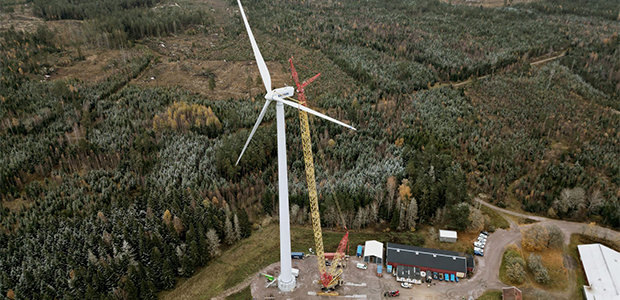
Modvion's Wooden Turbines Signal a New Era in Wind Power
The Swedish startup Modvion has recently achieved a significant milestone in renewable energy by constructing the world's tallest wooden turbine tower. This innovative approach to wind power, which champions the use of wood over traditional steel, marks a pivotal shift in the industry.
The turbine, towering at 150 metres to the tip of its highest blade, is equipped with a 2-megawatt generator. It has commenced supplying electricity to the Swedish grid, capable of powering approximately 400 homes. The ambition of Modvion extends beyond this feat; they envision taking wood and wind to even greater heights.
Traditionally, turbines are constructed from steel, a material known for its strength and durability. This has enabled the development of vast wind farms both onshore and offshore. However, Modvion firmly believes that wood represents the future of wind power.
As the demand for taller turbines has increased to enable the harnessing of stronger winds and accommodate larger generators, the size of the cylindrical steel towers supporting them has also had to increase. This growth has presented logistical challenges in transporting these large metal components to turbine sites, often constrained by infrastructure like road tunnels, bridges, and roundabouts. These logistical hurdles effectively limit the height of new steel turbines.
Externally, the wooden Modvion turbine bears a striking resemblance to its steel counterparts. Both types are coated in white paint to withstand the elements and feature blades predominantly made of fibreglass, attached to a generator that produces electricity when it rotates.
The strength of the 105-metre Modvion tower derives from its construction. It consists of 144 layers of laminated veneer lumber (LVL), forming its robust walls. By altering the grain orientation of each 3mm-thick spruce layer, Modvion claims to have achieved precise control over the tower's strength and flexibility.
At Modvion's factory near Gothenburg, these thin wood layers are glued and compressed to form curved sections. These sections are then transported to the site, where they are glued into cylinders and stacked to construct the tower.
The primary advantage of this wooden turbine is the modular construction approach. By using wood and glue, towers can be built in smaller, transportable modules, facilitating the construction of significantly taller towers and enabling installation in remote or challenging locations.
While wind power is among the cleanest and most cost-effective forms of electricity generation, traditional steel production for turbines involves high-temperature furnaces and the burning of fossil fuels, leading to considerable CO2 emissions. In contrast, Modvion's wooden turbines have a carbon-negative footprint. This is because the trees absorb CO2 from the atmosphere during their growth, and when harvested, the carbon remains sequestered in the wood, provided it is not burned or left to rot.
Approximately 200 trees, the same species used for Christmas trees, were used in constructing Modvion's turbine tower. The company emphasises sustainable forestry practices, ensuring that more trees are planted to replace those harvested.
In comparison to other electricity sources in Europe in 2020, the average emissions intensity varies significantly. Coal ranges from 850 to 1,000 grams of CO2 equivalent per kilowatt-hour, natural gas stands at 430, solar PV at 11 to 37, wind at 12 to 14, and nuclear at 5.1.
Looking ahead, Modvion plans to construct an even taller turbine and aims to open a facility by 2027 that could produce 100 wooden modular turbines annually. This ambitious goal underlines the company's commitment to revolutionising the wind energy sector and contributing to a more sustainable future.

